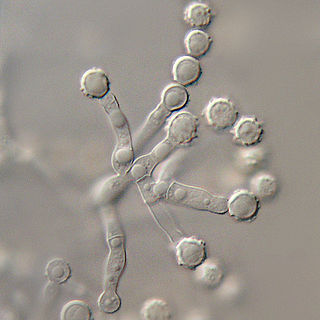Related Research Articles

Sordariomycetes is a class of fungi in the subdivision Pezizomycotina (Ascomycota). It is the second-largest class of Ascomycota, with a worldwide distribution that mostly accommodates terrestrial based taxa, although several can also be found in aquatic habitats. Some are phytopathogens that can cause leaf, stem, and root diseases in a wide variety of hosts, while other genera can cause diseases in arthropods and mammals.
Prunus arborea is a species of plant in the family Rosaceae. It is found in Indonesia, Malaysia, Singapore, and Thailand.

Pleosporaceae is a family of sac fungi. They are pathogenic to humans or saprobic on woody and dead herbaceous stems or leaves.

Diaporthales is an order of sac fungi.

The Microascaceae are a family of fungi in the class Sordariomycetes, subclass Hypocreomycetidae. The family was published by David Malloch in 1970, an emended description based on Everet Stanley Luttrell's original 1951 publication. Family was updated in 2020.
Griphosphaerioma is a genus of fungi in the family Amphisphaeriaceae. It is also in the Subclass Xylariomycetidae O.E. Erikss & Winka and order Amphisphaeriales D. Hawksw. & O.E. Erikss.
Tirisporella is a genus of fungi in the class Dothideomycetes. The relationship of this taxon to other taxa within the class was unknown, until 2015 when it was placed in order Diaporthales. A monotypic genus, it contains the single species Tirisporella beccariana(Ces.) E.B.G. Jones, K.D. Hyde & Alias (1996) which was found on the from the mangrove palm Nypa fruticans.

The Trypetheliaceae are a family of mainly lichen-forming fungi in the order Trypetheliales. The family consists almost exclusively of corticolous (bark-dwelling), crustose lichens with an almost strictly tropical distribution.
The Trichosphaeriales are an order of sac fungi. It is monotypic, and consists of the single family, the Trichosphaeriaceae. In 2017, the family of Trichosphaeriaceae was placed in Diaporthomycetidae families incertae sedis, which was accepted by Wijayawardene et al. (2018), and Wijayawardene et al. 2020. The order of Trichosphaeriales was also unplaced. They are generally saprobic and pathogenic on plants, commonly isolated from herbivore dung.
Unisetosphaeria is a fungal genus in the family Trichosphaeriaceae. This is a monotypic genus, containing the single species Unisetosphaeria penguinoides, found on dead petioles and rhachides of the palms Eleiodoxa conferta and Nenga pumila in Sirindhorn Peat Swamp Forest, southern Thailand.
Conioscyphascus is a fungal genus in the Sordariomycetes class of the Ascomycota. The relationship of this taxon to other taxa within the class is unknown, and it has not yet been placed with certainty into any order or family. The genus, Conioscyphascus contains the single species Conioscyphascus varius, described as new to science in 2004. Until Conioscyphascus gracilis(Munk) Réblová & Seifert was found later in 2004.

The Annulatascaceae are a family of fungi in the monotypic order Annulatascales of the class Sordariomycetes of the Ascomycota. The family had not been assigned to any order, until 2020 when it was placed with a new order Annulatascales M.J. D'souza, Maharachch. & K.D. Hyde.
The Papulosaceae are a family of fungi in the class Sordariomycetes and in the subclass Diaporthomycetidae. The family has not been assigned to any order. A monotypic taxon, the Papulosaceae contained the single genus Papulosa, which in turn contains the single species Papulosa amerospora. This species, found in the eastern USA, grows in Juncus stems.

Annulatascus is a genus of fungi in the Annulatascaceae family of the Ascomycota. The relationship of this taxon to other taxa within the Sordariomycetes class is unknown, and it has not yet been placed with certainty into any order. The genus is characterized by taxa that are saprobic on submerged, decaying plant material in freshwater habitats. Morphologically the taxa possess dark brown to black perithecia, long tapering hyaline septate paraphyses, eight-spored asci with relatively massive J− apical rings, and ascospores that may or may not possess gelatinous sheaths or appendages. There are currently 17 species included in the genus.
The Ceratostomataceae are a family of fungi in the phylum Ascomycota, class Sordariomycetes, subclass Hypocreomycetidae and order Coronophorales.
Appendicospora is a genus of fungi in the family Apiosporaceae.

The Magnaporthales are an order of fungi within the class Sordariomycetes and subclass Diaporthomycetidae. It has several water based species and genera.
Conioscyphales is an order of freshwater and terrestrial fungi within the division Ascomycota. It is in the subclass Savoryellomycetidae and the class Sordariomycetes and the subdivision of Pezizomycotina.
Savoryellaceae is a family of aquatic based fungi. It is the only family in the monotypic order Savoryellales within the class Sordariomycetes, division Ascomycota.
Savoryella is a genus of freshwater and marine based fungi in the family Savoryellaceae and the order Savoryellales.
References
- 1 2 Lumbsch TH, Huhndorf SM. (December 2007). "Outline of Ascomycota – 2007". Myconet. 13. Chicago, USA: The Field Museum, Department of Botany: 1–58. Archived from the original on 2009-03-18.
- ↑ New species of Clohiesia and Paraniesslia collected from freshwater habitats in China Lei Cai and Kevin D. Hyde Mycoscience Volume 48, Number 3 June 2007
- ↑ A new species of Clohiesia from Hong Kong K. M. Tsui, Kevin D. Hyde and I. John Hodgkiss Mycoscience Volume 39, Number 3 October 1998